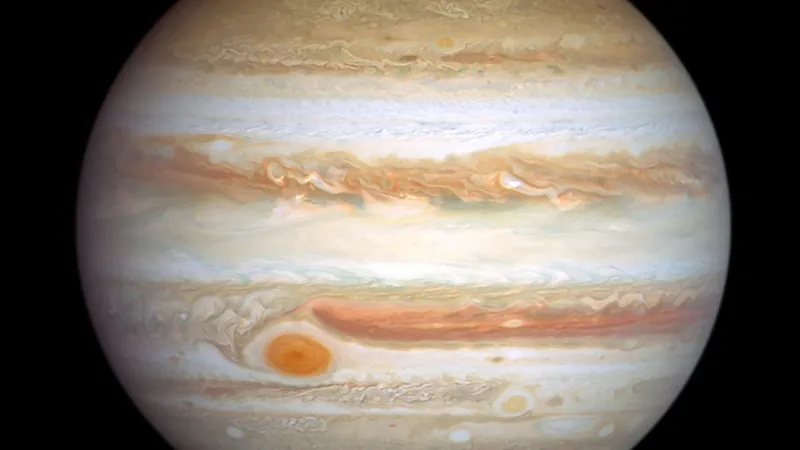
Amateur Astronomer Defies Expectations with Groundbreaking Discovery on Jupiter’s Atmosphere!
2025-01-09
Author: Ken Lee
Groundbreaking Discovery by Amateur Astronomer
In a stunning revelation, a collaboration between scientists and amateur astronomers has shaken the very foundations of what we believed about Jupiter's breathtakingly beautiful atmosphere. For years, it was a widely accepted notion that the planet’s iconic, swirling clouds are primarily composed of frozen ammonia. However, a meticulous study led by amateur astronomer Steve Hill challenges this long-held assumption.
New Insights from Spectral Analysis
Using commercially available telescopes and specialized spectral filters, Hill gathered data that mapped the ammonia abundance in Jupiter’s atmosphere. The results, however, deviated significantly from existing models, prompting a re-examination of the gas giant's atmospheric composition. "I was intrigued!” exclaimed Patrick Irwin from the University of Oxford. “At first, I was skeptical that the method Hill employed could yield such detailed ammonia maps, but as we analyzed the data, it became clear he had made a remarkable discovery."
Challenging Previous Models
Jupiter’s atmosphere is predominantly made up of hydrogen and helium, with trace amounts of ammonia, methane, water vapor, and other gases. While previous models posited that ammonia condenses at certain pressure levels, thus forming the clouds we see, new data from Hill suggests a far more complex reality. The observed cloud layers appear to form at much higher pressure and warmer temperatures than expected for ammonia clouds.
Innovative Band-Depth Analysis
The groundbreaking technique employed by Hill is referred to as band-depth analysis, which measures gas concentrations by examining light absorption at specific wavelengths. By examining the absorption bands of methane at 619 nm and ammonia at 647 nm—known features in Jupiter’s visible spectrum—he was able to derive a surprisingly accurate map of ammonia distribution across the planet's cloud tops.
Collaborative Confirmation
Irwin noted, “Because methane is well mixed in the atmosphere, it serves as a reliable reference. By comparing the reflection from these two absorption bands, we could determine not just the cloud-top pressure but also the relative abundance of ammonia.” What the findings revealed was astounding: the light reflected from cloud layers where atmospheric pressure was significantly greater than where ammonia could condense, effectively ruling out ammonia ice as the principal component of Jupiter’s clouds.
Composition of Jupiter’s Clouds
Instead, these clouds are likely comprised of ammonium hydrosulfide and possibly even smog produced by intricate photochemical reactions occurring within the atmosphere. Irwin mentioned that in many regions of Jupiter, ammonia gets broken down faster than it can be uplifted, meaning pure ammonia ice clouds are exceedingly rare and confined to specific areas of intense convection.
Future Explorations and Insights
To validate Hill's unexpected observations, Irwin and his team employed data from advanced instruments like the MUSE on the Very Large Telescope, NASA's Juno mission, and others. This collaborative approach not only confirmed Hill's findings but also paved the way for future explorations of Jupiter and similar outer planets, such as Saturn.
Importance of Understanding Ammonia Distribution
Understanding where ammonia exists and where it does not within Jupiter's atmosphere could provide critical insights into the planet's meteorological processes—a key step for comprehending both Jupiter and our solar system’s gas giants.
Caution and Future Research
While this breakthrough sends ripples of excitement through the scientific community, Irwin cautions about the limitations in their current model, emphasizing the need for an integrated approach to reconcile observations from various instruments. They plan to further investigate the vertical ammonia profile across varying altitudes in Jupiter's atmosphere to refine their understanding.
Technique Applied to Saturn
Impressively, the technique developed by Hill has already been successfully applied to Saturn, revealing that similar photochemical processes may operate in its atmosphere as well.
A New Era of Collaboration
This remarkable collaboration proves that contributions from both amateur and professional astronomers alike can yield groundbreaking insights into the cosmos. With ever-evolving techniques and persistent inquisitiveness, our understanding of the universe continues to grow, suggesting that there are still many secrets about the planets waiting to be uncovered. Stay tuned, as the cosmos has plenty more surprises in store!


 Brasil (PT)
Brasil (PT)
 Canada (EN)
Canada (EN)
 Chile (ES)
Chile (ES)
 Česko (CS)
Česko (CS)
 대한민국 (KO)
대한민국 (KO)
 España (ES)
España (ES)
 France (FR)
France (FR)
 Hong Kong (EN)
Hong Kong (EN)
 Italia (IT)
Italia (IT)
 日本 (JA)
日本 (JA)
 Magyarország (HU)
Magyarország (HU)
 Norge (NO)
Norge (NO)
 Polska (PL)
Polska (PL)
 Schweiz (DE)
Schweiz (DE)
 Singapore (EN)
Singapore (EN)
 Sverige (SV)
Sverige (SV)
 Suomi (FI)
Suomi (FI)
 Türkiye (TR)
Türkiye (TR)
 الإمارات العربية المتحدة (AR)
الإمارات العربية المتحدة (AR)